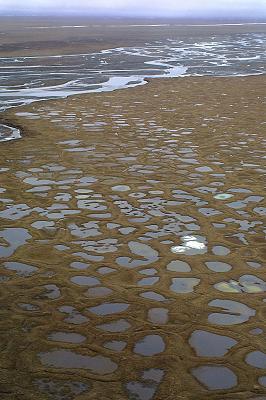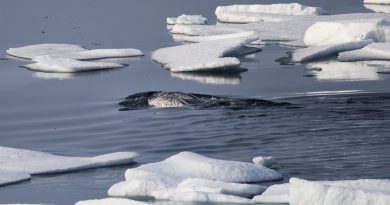No end in sight for ANWR campaigns

Congress is so stuck in partisan mire it hardly passes any bills these days.
So it would seem unlikely it could pass anything as controversial as opening the Arctic National Wildlife Refuge to drilling. Still, two campaigns, Arctic Power and Alaska Wilderness League, remain on the job in Washington, D.C. One has been fighting for 20 years to allow oil development on the coastal plain of the refuge, the other working just as long to ensure that day never comes.
These days, Arctic Power operates out of a hotel-like building in the fashionable Penn Quarter area of Washington, known for its proximity to galleries and restaurants. It’s actually an apartment building. Campaign chief Adrian Herrera says Arctic Power recently emerged from warm shut-down status. For a few years, it had no real office.
“The last Alaska Legislature grant allowed us to lease this office and have a second employee, so we’ve have this operation for a year,” he says.
Herrera’s own apartment is in the same building, so his is a very short commute.
Listen to the full report from Alaska Public Radio Network:
Differences between Alaskans and other Americans
Arctic Power was founded in 1992, so long ago its torch has passed to a new generation. Adrian Herrera’s father is Roger Herrera, a former BP executive who ran the campaign for years. The second employee now working with Adrian is Michael Shively, who also has family roots in resource development advocacy. His uncle is John Shively, CEO of the Pebble Mine partnership.
Herrera says he understands Alaskans are frustrated Arctic Power’s work isn’t finished yet. When Congress created the Arctic Refuge in 1980, a section of the law, numbered 10-02, left the fate of its northern edge in limbo. Polls show Alaskans overwhelmingly favor oil drilling there, but that would take another act of Congress, and polls show most Americans hate the idea. So Arctic Power keeps trying, even now, with the Senate and the White House in the hands of committed opponents of ANWR development and the nation awash in oil from North Dakota and Texas.
Herrera says it’s the central conundrum of ANWR: Alaskans believe in responsible oil extraction while other Americans want this distant place locked up.
“It’s the difference between the people who live there and find their living off the land, who eat and work on the land every single day, and a state that gets nearly its entire income from that land use, versus people who’ve never been there,” he says.
But Herrera says circumstances can shift suddenly in Washington, and Arctic Power needs to be ready. When gasoline prices climb, for instance, lawmakers are more inclined to open ANWR.
“ So in this world of Capitol Hill and politics you never say never,” Herrera says. “Absolutely realistically speaking, would Harry Reid allow a bill on ANWR to reach the floor of the House? Very unlikely. Would the president threaten to veto it, absolutely, down to the last minute …. (But) you fight the fight until the very end. You don’t give up … . I mean, yes, realistically, if it came to the floor under current situations — Well, it probably wouldn’t even come to the floor, but is the debate still going on in hearings? Absolutely. Are the public still listening? Absolutely.”
Arctic Power

Financially, Arctic Power has had fat years and lean years. Oil companies pulled out long ago, so the group’s primary funder has been the state of Alaska, which has contributed $12 million over the years – sometimes a million or two a year, sometimes a tenth of that. Still Herrera calls it a grassroots organization.
“Not all our funding does come from the state,” Herrera says. “We have a considerable amount of our funding that comes from private donations (reporter, off mic: Like what percentage?) … I’m not at liberty to say that.”
Public records on file with the IRS show other contributions are miniscule. The most recent, a lean year ending mid-2012, shows private donors gave Arctic Power $1,200. They were outspent 100-to-1 by the state. The group did better at bingo – receiving $20,000 in charitable gaming receipts from an Anchorage bingo parlor.
In Arctic Power’s war room – the living room of an open-plan two-bedroom suite – lists of bill numbers are tacked to the wall, favorable bills in black ink, bills they don’t like in red. Herrera says the group is no longer solely devoted to opening the coastal plain of ANWR. These days, they’re also working to encourage development to the west, in the National Petroleum Reserve- Alaska, and off-shore — all with the aim, he says, of filling the trans-Alaska Pipeline.
He says the work is largely research and outreach, and shepherding visitors around Capitol Hill to help make the case.
”Our goal is to really monitor the Hill and as much as possible convince the public, convince state legislatures around the nation, other coalition groups … to support the effort,” he says. “What’s good for Alaska is good for America. That’s been our message from the beginning and it will be until the job is done.”
Alaska Wilderness League
About a mile away, just off the Capitol grounds, is the headquarters of Alaska Wilderness League, on the second floor of an unremarkable office block. Some 10 people work here, and 10 more in Alaska field offices. While Arctic Power’s budget recently doubled to $300,000, Alaska Wilderness League has an annual budget of more than $3 million. It initially focused only on the Arctic refuge but has since expanded into other Alaska issues, including logging. Despite its healthy budget, Arctic campaign director, Lydia Weiss, says they don’t lobby in fat-cat style.
“I don’t take members of Congress golfing. I don’t buy them steak dinners. We don’t have that sort of budget. That’s not how it works. I pick up the phone and I ask for time to meet with staff people and I sit down and do it the old fashioned way. And I tell them about this place and I tell them about the dynamics and I dispel myths and usually I win their support.”
Different strategies
Alaska Wilderness League chooses the more evocative route. They always call it the “Arctic National Wildlife Refuge” and the “coastal plain,” never “ANWR” or “10-02 area.” They use beautiful photographs and deploy interns dressed in polar bear suits. Weiss makes no apologies for the bear costumes. At rallies and protests, everyone from tourists to members of Congress wants to pose for photos with the bear. Weiss says the fur suits work as intended by drawing attention and, she says, reminding people what’s at stake.
Weiss, originally from New York state, also freely admits one of the worst accusations flung at her side: She’s never been to this coastal plain she’s devoting her career to.
“As if having been there is a threshold that one has to pass to care about the place!” She says. “It costs thousands of dollars for somebody to get into the coastal plain of the Arctic National Wildlife Refuge. If that’s a threshold for being able to care about this place, that’s a recipe for making sure that only the richest most elite people in American are allowed to weigh in on it. I’m not one of those people. I never had any expectations of going to the coastal plain of the Arctic National Wildlife Refuge. But one of the things that makes me proudest as an American is our wilderness ethic. And I, like most Americans that care about this place … like to know that America can do this right and we can protect our most special places. Not for us, and not for recreation but for future generations and for the wildlife that depends on it.”
A time to gain ground
A few years ago, when Republicans controlled Congress and the White House, Alaska Wilderness League was playing defense. Now, Weiss says, is the time for her side to gain ground.
“When there’s an immediate threat to the Arctic National Wildlife Refuge, we all, this entire community,… comes together to defend it, and we always win,” she says. “There is less attention on the coastal plain of the Arctic National Wildlife Refuge when that immediate threat isn’t there, and Alaska Wilderness League was founded and exists today in part to make sure we’re taking advantage of opportunities for offensive gains when the threats aren’t as immediate.”
Senators who champion their effort, Maria Cantwell of Washington and Mark Kirk of Illinois, recently introduced a bill that would declare the coastal plain of ANWR a wilderness area, forever off-limits to oil development. It’s a recurring favorite for environmentalists but people on both sides of the issue say the same thing when asked about its chances of becoming law: It would be hard to get anything this controversial through Congress.
-By Liz Ruskin, APRN – Washington DC
Related Links:
Alaska presents new plan for ANWR development, APRN
Arctic Ocean vs. ANWR: Is wildlife refuge last hope for polar bears, Alaska Dispatch



